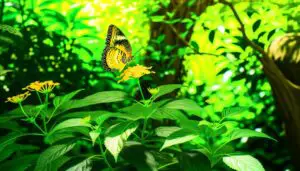Milkweed Seeds for Monarch Butterflies
Milkweed seeds are essential for the conservation of monarch butterflies (Danaus plexippus), serving as the exclusive host plant for their larvae and providing important nectar for adults. The depletion of milkweed due to habitat destruction and herbicide use has led to a significant decline in monarch populations.
Strategic planting of species like Asclepias syriaca and Asclepias tuberosa can enhance larval survival rates. Additionally, native milkweed varieties are important as they show higher larval survival compared to non-native species.
Proper site selection, seed stratification, and ongoing care are fundamental for successful growth and ecological benefits, promising more thorough insights ahead.
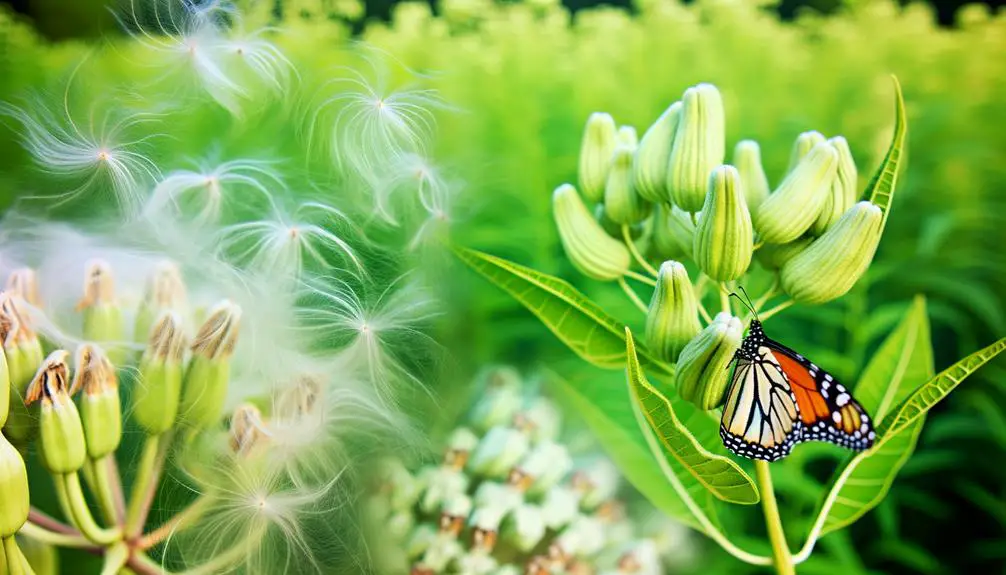
Key Takeaways
- Milkweed is essential for monarch larvae, providing food and protection through toxic cardenolides.
- Native milkweed species like Asclepias syriaca support higher larval survival rates compared to non-native varieties.
- Planting milkweed in full sun with well-drained soil maximizes growth and ecological benefits.
- Seed stratification by cold treatment improves milkweed germination rates.
Importance of Milkweed
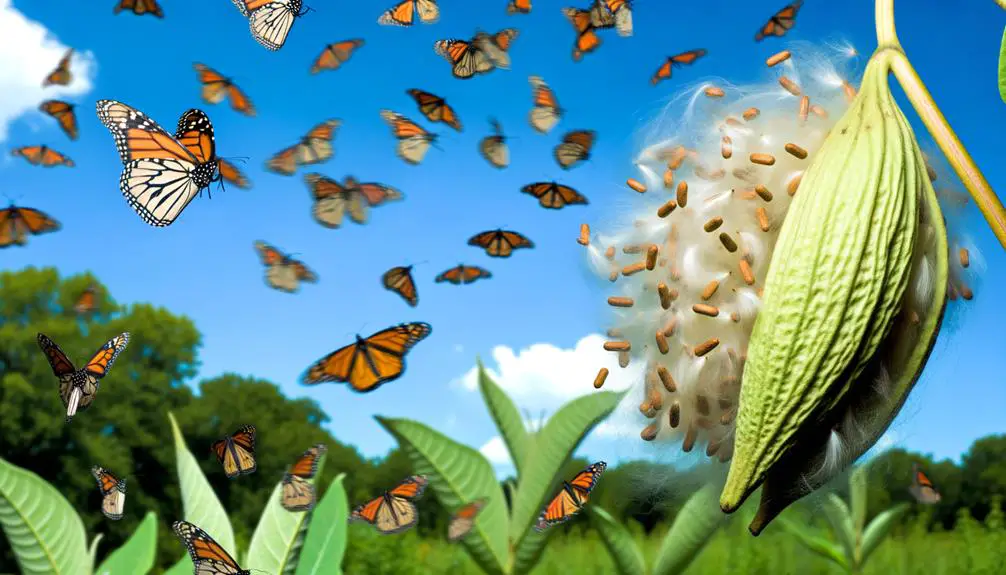
Milkweed (Asclepias spp.) is a critical host plant for the larvae of the monarch butterfly (Danaus plexippus), providing both essential nutrients and habitat for their development.
This plant's leaves contain cardenolides, toxic compounds that monarch larvae sequester, rendering them unpalatable to predators.
Data from ecological studies indicate that a decline in milkweed availability directly correlates with reduced monarch populations. Specifically, habitat destruction and herbicide use have diminished milkweed prevalence by over 58% in North America.
Restoration efforts focusing on milkweed propagation have shown promise; areas with increased milkweed density exhibit higher larval survival rates.
Consequently, ensuring the proliferation of milkweed is imperative for the conservation of monarch butterflies, supporting both their life cycle and ecological resilience.
Monarch Butterfly Lifecycle
The monarch butterfly (Danaus plexippus) undergoes a complex lifecycle comprising four distinct stages: egg, larva (caterpillar), pupa (chrysalis), and adult.
During the egg stage, females lay approximately 300 to 500 eggs individually on milkweed plants. These eggs hatch into larvae within 3 to 5 days.
The larval stage, characterized by five instars, lasts around 10 to 14 days, during which the caterpillar consumes milkweed leaves exclusively.
Following this, the larva forms a pupa, or chrysalis, entering a metamorphic phase lasting approximately 10 days.
Types of Milkweed
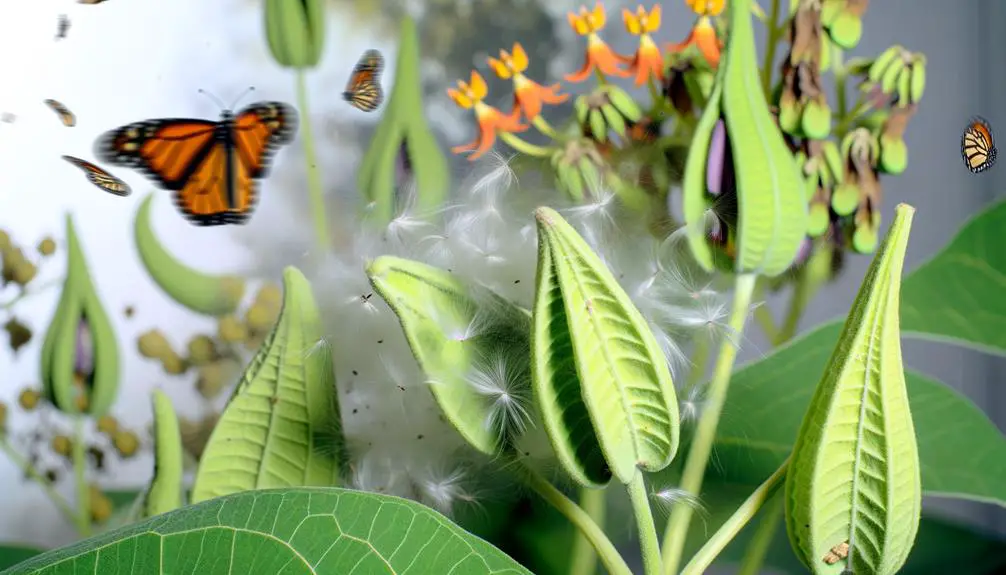
Milkweed species play a vital role in the conservation of monarch butterflies, with specific varieties like Asclepias syriaca (Common Milkweed) and Asclepias curassavica (Tropical Milkweed) offering unique benefits.
Common Milkweed is widely distributed across North America and serves as a primary host plant for monarch larvae.
In contrast, Tropical Milkweed, while offering extended flowering periods and higher nutritional value, has raised ecological concerns regarding its impact on migratory patterns.
Common Milkweed Varieties
Several key species of milkweed provide crucial habitats and food sources for monarch butterflies during their lifecycle.
Asclepias syriaca, commonly known as common milkweed, is predominant in North America, thriving in various soil types.
Asclepias incarnata, or swamp milkweed, flourishes in wetland areas and offers high nutritional value.
Asclepias tuberosa, recognized as butterfly weed, is distinguished by its vibrant orange flowers and drought-resistant properties.
These species are essential, as they contain cardenolides, toxic compounds that deter predators when ingested by monarch larvae.
According to recent studies, monarchs prefer Asclepias curassavica, yet native species like A. syriaca and A. incarnata show higher survival rates for larvae.
Promoting diverse milkweed species guarantees a resilient support system for monarch populations.
Tropical Milkweed Benefits
Tropical milkweed (Asclepias curassavica), characterized by its vibrant red and yellow flowers, provides year-round resources for monarch butterflies in warmer climates. This species offers several ecological benefits that are significant for monarch conservation efforts:
- Extended Bloom Period: Unlike temperate milkweed species, tropical milkweed blooms continuously, ensuring a consistent nectar source.
- Larval Host Plant: It serves as a vital host plant for monarch larvae, providing necessary nutrients for their development.
However, it is essential to manage tropical milkweed responsibly to avoid disrupting monarch migration patterns and overwintering sites.
Proper cultivation practices can maximize its benefits while minimizing ecological risks.
Selecting Seeds
Given the crucial role of milkweed in the lifecycle of monarch butterflies, selecting the appropriate species for your region is necessary for successful cultivation and conservation efforts. Different milkweed species exhibit varying tolerances to climate, soil type, and moisture levels, impacting their viability and ecological benefits.
| Species | Climate Tolerance | Soil Preference |
|---|---|---|
| Asclepias tuberosa | Dry, well-drained | Sandy, loamy |
| Asclepias syriaca | Temperate, cold-hardy | Clay, sandy loam |
| Asclepias incarnata | Moist, wetland areas | Loamy, clay |
| Asclepias curassavica | Tropical, subtropical | Well-drained, rich |
Choosing the correct milkweed species guarantees peak growth and attracts monarchs, aiding in their conservation by providing critical habitat and resources. Implementing data-driven decisions enhances both ecological benefits and plant health.
Planting Milkweed
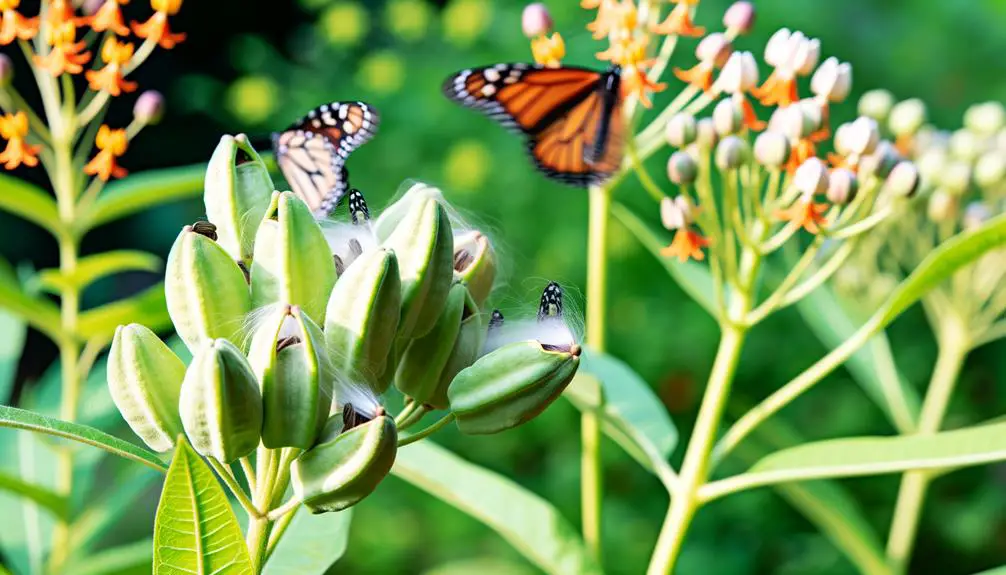
To successfully plant milkweed, one must consider site preparation, planting methods, and ideal timing to guarantee robust growth and maximum benefits for monarch butterflies.
Selecting a site with full sun exposure and well-drained soil is essential. Prior to planting, the soil should be tilled to eliminate weeds and secure proper aeration. Seed stratification, involving cold treatment, enhances germination rates.
- Sow seeds directly: Scatter seeds on the soil surface and gently press them into the ground.
- Planting depth: Confirm seeds are no deeper than 1/4 inch to facilitate peak growth.
Proper planting techniques are fundamental to fostering a thriving milkweed habitat for monarch butterflies.
Caring for Plants
Once the milkweed is planted, maintaining ideal conditions through proper care is essential to guarantee healthy growth and sustained support for monarch butterfly populations.
Soil moisture must be consistently monitored, making sure it remains well-drained yet adequately hydrated.
Employ a balanced fertilizer with a nitrogen-phosphorus-potassium (NPK) ratio of 10-10-10 to enhance nutrient availability.
Pruning should be performed judiciously to remove damaged or diseased foliage, promoting vigorous growth.
Regularly inspect for pests such as aphids, implementing biological controls like ladybugs to minimize chemical interventions.
Sunlight exposure is critical; verify the plants receive a minimum of six hours of direct sunlight daily.
Documenting these parameters facilitates data-driven adjustments, making certain milkweed thrives and continues to provide essential resources for monarch butterflies.
Common Challenges
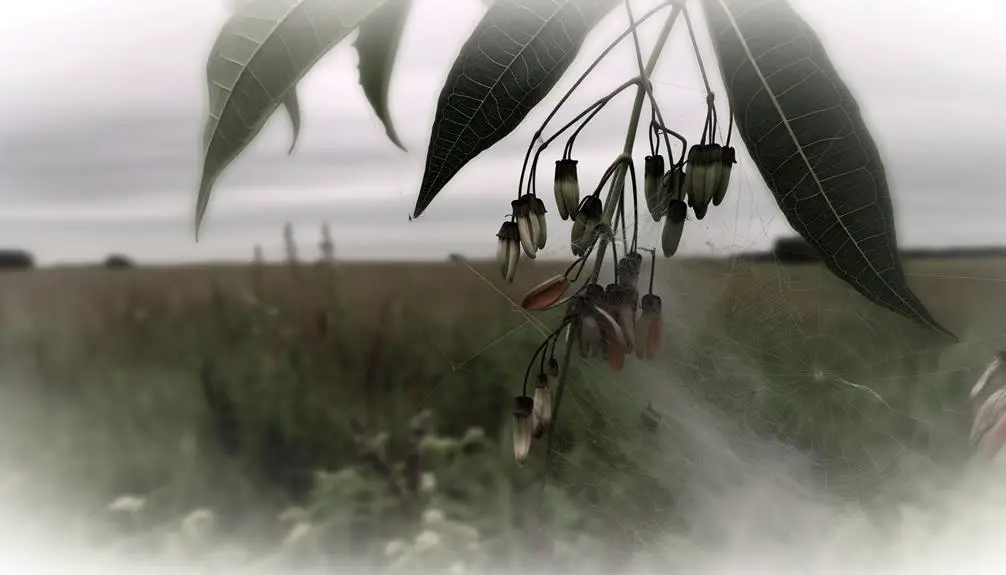
Cultivating milkweed for monarch butterflies often presents challenges such as susceptibility to pests, diseases, and environmental stressors that require strategic management. These factors can greatly impact the plant's viability and ecological function.
Key challenges include:
- Aphid Infestations: Aphids, particularly Myzus persicae, can cause considerable damage, necessitating integrated pest management strategies.
- Fungal Pathogens: Milkweed is prone to diseases such as root rot caused by Pythium spp., requiring vigilant monitoring and soil management.
Addressing these issues with precision and proactive measures guarantees the sustainability of milkweed populations, thereby supporting the lifecycle of monarch butterflies.
Environmental Benefits
Planting milkweed seeds greatly contributes to habitat restoration, providing essential breeding grounds for monarch butterflies.
This practice also supports broader pollinator populations, as milkweed attracts various insects vital for ecosystem stability.
Data indicates that increased milkweed prevalence correlates with higher biodiversity and improved ecological health.
Habitat Restoration Impact
Restoration of milkweed habitats has shown significant environmental benefits, including increased biodiversity and improved ecosystem resilience.
Empirical studies indicate that milkweed reestablishment positively impacts various ecological parameters. For instance, diverse flora and fauna benefit from the presence of milkweed, which serves as a keystone species within these ecosystems.
The multifaceted advantages are as follows:
- Enhanced soil health: Milkweed roots contribute to soil aeration and nutrient cycling.
- Increased native plant diversity: Milkweed provides a competitive edge for native species by outcompeting invasive plants.
These factors collectively fortify ecosystem stability, ensuring the sustainability of habitats essential for myriad species, thereby promoting ecological balance and resilience.
Pollinator Population Support
The reestablishment of milkweed habitats provides critical support to pollinator populations, particularly monarch butterflies, by supplying essential breeding grounds and nutritional resources.
Monarchs rely exclusively on milkweed for oviposition and larval development. A study by the Xerces Society for Invertebrate Conservation indicates a 90% reduction in monarch populations over the past two decades, largely due to habitat loss.
Additionally, milkweed flowers offer nectar to a variety of pollinators, contributing to ecosystem biodiversity. Enhancing milkweed prevalence can mitigate these declines, fostering resilience in pollinator communities.
Data from the U.S. Fish and Wildlife Service demonstrate that targeted milkweed planting initiatives can increase local monarch populations by up to 50%, underscoring the significance of these habitats in ecological conservation efforts.
Conclusion
To sum up, the cultivation of milkweed is essential for the survival of monarch butterflies, as it provides critical habitat and nourishment throughout their lifecycle.
Selecting appropriate milkweed species, planting, and proper care can greatly enhance monarch populations.
Despite challenges such as pests and climate conditions, the environmental benefits, including biodiversity promotion and ecological balance, are considerable.
As the adage goes, 'A stitch in time saves nine,' emphasizing the importance of timely conservation efforts for sustained ecological health.





